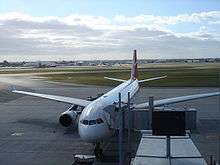Perth Airport
Perth Airport (IATA: PER, ICAO: YPPH) is an international airport serving Perth, the largest and capital city of Western Australia. It is the fourth busiest airport in Australia measured by passenger movements[2] and falls within the boundaries of the City of Belmont, City of Kalamunda and the City of Swan.[3] Perth Airport and Jandakot Airport, the other civilian airport within the Perth metropolitan area, recorded a combined total of 362,782 aircraft movements in 2017.[4]
Perth Airport | |||||||||||||||
|---|---|---|---|---|---|---|---|---|---|---|---|---|---|---|---|
 | |||||||||||||||
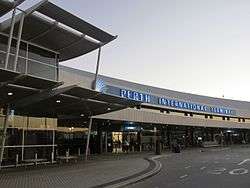 | |||||||||||||||
| |||||||||||||||
| Summary | |||||||||||||||
| Airport type | Public | ||||||||||||||
| Owner | Consortium including Australian Government Future Fund, Utilities Trust of Australia, AustralianSuper, Citicorp | ||||||||||||||
| Operator | Perth Airport Pty. Ltd. | ||||||||||||||
| Serves | Perth, Western Australia | ||||||||||||||
| Location | Perth Airport, Western Australia | ||||||||||||||
| Hub for |
| ||||||||||||||
| Focus city for |
| ||||||||||||||
| Elevation AMSL | 67 ft / 20 m | ||||||||||||||
| Coordinates | 31°56′25″S 115°58′01″E | ||||||||||||||
| Website | www | ||||||||||||||
| Map | |||||||||||||||
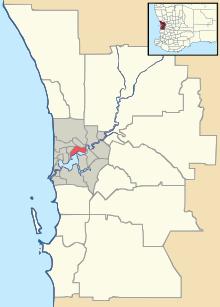 PER  PER  PER | |||||||||||||||
| Runways | |||||||||||||||
| |||||||||||||||
| Statistics (YE June 2016) | |||||||||||||||
| |||||||||||||||
Since 1997, it has been operated by Perth Airport Pty Limited, a private company (formerly Westralia Airports Corporation Pty Ltd) under a 99-year lease from the Commonwealth Government.[5]:p 48
In 2012, the Australian Competition and Consumer Commission (ACCC) released a report rating the Perth Airport as the worst in Australia, as judged by airlines. The same report rated it below satisfactory for the second year in a row.[6] However, due to recent expansions and projects, the airport was awarded Capital City airport of the year by the Australian Airports Association at their national conference in 2016.[7] In 2018, Perth Airport was named the best airport in Australia for overall service quality by the ACCC after the completion of a $1 billion redevelopment project over the span of 5 years.[8] The first direct service from Oceania to Europe commenced in 2018, with Qantas operating daily return flights to London Heathrow using a Boeing 787-9 from Perth.
Location
The airport is located approximately 10 km (6.2 mi) east of the Perth central business district. It is one of two civilian airports within the Perth metropolitan area, the other being Jandakot Airport. Besides the civilian airports, there are also two military airports within the Perth metropolitan area. The larger of the two is RAAF Base Pearce, 30 km (18.6 mi) to the north of Perth Airport, at Bullsbrook. The other is 42 km (26.1 mi) south west of Perth Airport, and is a part of the military base of HMAS Stirling on Garden Island.
Growth and impact
The airport saw strong passenger growth from 2000 to 2012, primarily due to the state's prolonged mining boom and an increase in traffic from international low-cost carrier airlines. By the end of June 2012, Perth Airport experienced passenger growth of 11.7% internationally and 6.9% domestically, resulting in an overall increase of 10.3%. Passenger numbers trebled in the 10 years from 2002 to 2012 with more than 12.6 million people travelling through the airport in 2012. Since 2012, the winding down of the mining boom has seen the demand for both intra- and interstate services contract, with domestic passengers falling from a peak of 9.9 million (as of June 2013) to 9.5 million by the end of June 2016. The growth in passenger numbers since 2012 has been wholly due to expansion of international services from the city. The first mining boom in 1979 had 679,000 passengers use the airport. This number now travels through the airport every eighteen days.
As well as passenger movements however, complaints about the impact of the airport on the residents of Perth have grown.[9][10] The City of Canning, one area that is affected, accepts that “aircraft noise is an important issue” and that “aircraft noise does impact heavily on those suburbs under the flightpaths.”[11] Another affected area, the City of Swan, “has experienced significant issues.”[12] Indeed, planning policy adopted by the Government of Western Australia recognises that some aircraft noise is “not compatible with residential or educational” land use,[13] two fundamental uses of land in any conurbation that is home to over two million residents—such as Greater Perth.
History
Early days
Prior to the opening of the Perth Airport, civilian air services for the city were provided from Maylands Airport located in Maylands (in operation since 1924), as well as on the city's foreshore at Langley Park.[14] By the end of the 1930s, it became clear that the Maylands Aerodrome was limited in the size and speed of aircraft it was able to handle thus causing them to seek an alternative site for a future airport.[14]
Site selection and preparation of the original plans was undertaken by Mr N M Fricker of the Department of Civil Aviation.[15] In 1938, land was selected and purchased for the new aerodrome. The site selected in what was at the time Guildford, was an area of land granted by Governor James Stirling to local man John Scott, which later became the long disused Dunreath Golf Course.[14][15]
A plaque located on a roadside wall of the old International terminal remains in permanent memory of Scott:[15]
Perth Airport stands on part of an area granted originally by Governor James Stirling to John Scott. A yeoman farmer from Lanarkshire, Scotland who arrived in Western Australia in March 1831, after a voyage of about 90 days in the schooner Eliza of 343 tons. He came at the invitation of the governor, to establish and maintain a bloodstock farm for the colony. He made his home near Guildford, using the Swan River to reach the farm in this area.
In recognition of his services Governor Stirling granted him lease of an area at Bunbury, where he became the first settler in 1838.
Remember him as one who helped to bring prosperity to this land.[15]
— Text of roadside plaque in memory of John Scott.
Military operations
Even before civil aviation operations could commence at the new site, the onset of World War II saw the facility being redesigned for military purposes as a temporary base for the Royal Australian Air Force and United States Navy, known as "RAAF Station Guildford", primarily to supplement RAAF Base Pearce.[14] Royal Australian Air Force No. 85 Squadron was based there from February 1943.
Despite military use of the airfield, civil services operated by Qantas Empire Airways and Australian National Airways (ANA) commenced from the location in 1944.[14] This was despite bitter protest from military authorities who felt civilian operations would undermine the defence and camouflage needs of the location.[14]
The move was agreed to by the government of the day, as the larger types of aircraft of the day being operated by the two airlines could simply not be handled at Maylands, notwithstanding the small grass airfield, lack of passenger facilities, and approaches being difficult due to surrounding industrial infrastructure.[14] Using Douglas DC-3 aircraft, ANA flew the first commercial service from the aerodrome to Adelaide.[14] On 17 June 1944, Qantas made its inaugural flight to Ceylon via Exmouth using a modified Liberator bomber, arriving in Perth on 3 June 1944 having been released to the airline by the British Government.[14]
Early civilian operations
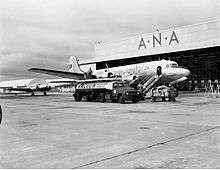
Full civilian operations at the Guildford Aerodrome commenced in 1944.[15] Civil operations at Maylands continued albeit reduced until 30 June 1963, when the airport closed and its function as a secondary airport was taken over by Jandakot Airport the very next day.[14]
The Guildford Aerodrome as it was then known was at best only a basic airfield.[14] On a large open airfield with plenty of space, an unobtrusive control tower was hidden away amongst a collection of buildings inherited from the wartime operations at the site.[14] The then Department of Civil Aviation inherited a large number of operating vehicles from the former military occupants, including an assortment of vehicles including "Blitz" wagons, Dodge command cars and weapon carriers, large trucks and various makes of fire tenders, jeeps and ambulances.[14] Boarding aircraft at Guildford was described as being a bit like boarding a bus given the lack of passenger facilities at the time.[14]
In 1948, the Horrie Miller owned MacRobertson Miller Aviation Co. (MMA) relocated from Maylands to Guildford.[14] followed by newly formed government airline Trans Australia Airlines (TAA) on 2 December of that same year, operating Douglas C-54 Skymasters on its Perth – Melbourne – Sydney route.[14] Due to the lack of road transportation across the Nullarbor Plain, it was at this time that Guildford became the scene of very busy cargo operations.[14] Fresh fruits, vegetables, and manufactured goods were being flown from east to west and back again.
The airport received international status and was renamed to Perth International Airport in only 1952.[14] Officiated by the then Federal Minister for Civil Aviation, Hubert Anthony, the official ceremony for the renaming took place on the main apron in front of a converted Bellman hangar used by TAA as its passenger terminal.[14] At the time, a new international terminal building was under construction but had not been completed in time for the ceremony.[14] This new terminal was being constructed using steel and cladding recycled from American-built military quonset buildings being dismantled and shipped over from Manus Island.[14]
It was also on this day that Qantas commenced its Wallaby service using the Constellation Charles Kingsford Smith" (VH-EAD) from Sydney to South Africa via Western Australia, the Cocos Islands, and Mauritius.[14]
The jet age
Towards the mid-1950s, airline travel was still being used by only a small percentage of the population. At that time, only 8% of the population had ever flown, but as the marketplace evolved, so did the types of people and their reasons for flying.[14]
It was at this time the airport began to experience the full effects of the jet age. Although both Air India and Qantas commenced operating Boeing 707s in the mid to late 1950s from Perth to Singapore and the sub continent[14] the aircraft of the day grew faster and more demanding due to their sophistication, facilities at the airport continued to improve to accommodate them.[14] By the mid-1960s the airport commenced seeing its first domestic pure jet engine aircraft, commencing with a Boeing 727 in 1964, and the Douglas DC-9 in 1967, both types operated by TAA and Ansett ANA.[14] It was at this time that the airport was one of the few major airports in the country which operated without curfews, and due to the increased number and frequency of flights operating from the airport it gave birth to what was then referred to as the midnight horror or red-eye special, known in more recent history as the red-eye flight.[14]
Demise of the hangar terminals
In 1960, the current international terminal previously constructed from steel and cladding from Manus Island was dismantled and then re-erected in the suburb of Cannington.[14] Known as The Alco Building, it was re-designed for use as a commercial facility.[14]
The removal of the steel structure made way for the construction of an entirely new combined domestic and international passenger terminal, constructed on the northern side of the airfield.[14] It was in 1962 that airlines were able to move from their hangars into a new combined passenger terminal, designed by the Commonwealth Department of Works and opened just in time to handle 1962 British Empire and Commonwealth Games traffic increases.[14][15] The new combined terminal was opened that same year by then Minister for Civil Aviation, Senator Shane Paltridge; it was located in an area positioned between Terminals 3 and 4 and is currently used as the crew base for both Qantas and Skywest, and offices for airlines and support firms.[14][16]
International terminal development
From 1962 onwards, both the domestic and international passenger operations at the airport were provided by a single terminal.[16] However, by the arrival of the Boeing 747 on 3 September 1971, the existing terminal had reached its capacity, and modelling of future passenger numbers showed it would be unable to handle any further increases in passenger demand.[14][16]
In November 1980, the Federal Transport Minister, Ralph Hunt, announced that a new international terminal would be built in Perth at a cost of A$26 million (1980).[14] Design of the new International Terminal commenced in 1982, with one of the key principles of the design being the allowance for easy future expansion as the needs of the airport dictated.[16] The project called for the construction of a new terminal, apron, airside roads, access roads, car parks and other passenger facilities.[16]
Construction of the new International Terminal and control tower commenced in March 1984 on the south-eastern side of the airfield.[16] In 1984, the road leading to the new terminal, Horrie Miller Drive was named in honour of local aviation pioneer Horrie Miller.[17] The terminal was officially opened on 25 October 1986 by then Prime Minister Bob Hawke, with the new terminal receiving passengers just days after.[14][16] The newly built control tower was the tallest in Australia at its time of construction, and remains to be the tallest in Australia.[18]
Upon completion, the terminal was able to process up to five Boeing 747 aircraft per hour and accommodated a peak passenger volume of 6,000 passengers per hour.[16] Twenty years later, in the 12 months to June 2006 the terminal processed over 2.027 million passengers, surpassing a 1996 projection of 1.016 million passengers in that period.[16]
1988 onwards
In the late 1980s the Federal Government, as a prelude to eventual privatisation, formed the Federal Airports Corporation (FAC). In 1988, FAC took over as manager of Perth Airport (and many other Australian airports).[14]
At this time also, airline operators Qantas and Ansett set about on ambitious capital works programs to construct new domestic terminals for their respective airlines on the northern side of the terminal, where they still stand to this day.[14]
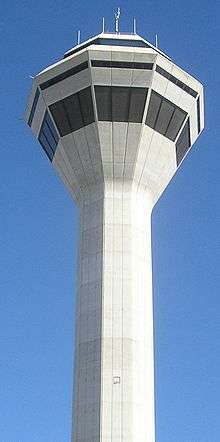
In 2001, after the financial collapse of Ansett, the Ansett terminal became a multi-user terminal, catering for flights from former Ansett-subsidiary Skywest, as well as Virgin Australia and now charter airlines including Alliance Airlines and previously Strategic Airlines (traded as Air Australia).
In July 1997 Perth Airport Pty Ltd took up a 99-year lease as part of the Federal Government's push to privatise airports.[19]
From 2003 to 2004, the International terminal underwent major internal refurbishments to provide an increased array of passenger services, including increased space for duty-free stores and food and beverage concession stands.[16] Further upgrades valued at $25 million (2006) were made to the terminal across 2005 and 2006 which added an additional 2,500 m2 (27,000 sq ft) of floor space, additional check-in counters, and an improved baggage handling and screening system.[16]
The airport commemorated its 60th anniversary in 2004, with an event that opened the new Taxiway Sierra, a new taxiway supporting larger aircraft such as the Boeing 747, Airbus A340, and potentially the Airbus A380 to operate at the airport.[20]
On 11 October 2007, Perth International Airport received the first test flight out of Terminal 3 at Changi International Airport, Singapore. The test flight was a Singapore Airlines flight that departed Changi Airport at 5:30 pm, landing in Perth at 11:30 pm.
On 14 October 2008, the Airbus A380 made its first visit to the airport as a part of the Qantas A380 promotional tour around Australia. The second A380 to visit the airport was an Emirates aircraft which made an emergency landing on 15 August 2009, after a passenger on the Dubai to Sydney flight suffered a stroke.[21]
On 1 February 2013, Qatar Airways was due to commence the first commercial service of the Boeing 787 Dreamliner aircraft into Australia on its daily services from Perth to Doha. However, due to the worldwide grounding of the 787 this was delayed indefinitely.[22] In 2016, Qatar stated that it intended to introduce the Airbus A350 aircraft on flights to Perth once they receive enough of the aircraft.[23] However, at the end of 2017 Qatar withdrew the plan, announcing that from May 2018 Perth would receive A380 services instead, making Qatar the second airline to operate scheduled A380 flights to Perth.
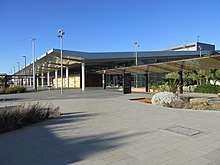
Terminal 2 was officially opened on 28 February 2013, with the first flights operating out of the terminal on 2 March 2013. The single story terminal was designed to provide;[24]
- At-grade access to terminal building,
- 16 common use check-in counters, including space for self-service and bag drop technologies,
- Centralised passenger security screening zone,
- Three baggage reclaim belts,
- Dedicated pick-up and drop-off lanes at the front of the terminal,
- 14 aircraft bays, accessible from enclosed walkways and serviced by 8 boarding counters, and
- 36 additional aircraft parking bays.
Philippine Airlines commenced flights from Manila to Perth on 2 June 2013, but were later withdrawn in September 2013. On 6 December 2019, it was announced that the route will be resumed on 30 March 2020 using the airline's Airbus A321neos.
In 2015 Emirates commenced the first Airbus A380 service to Perth from Dubai following the completion of a dual level boarding gate, an expanded check-in hall, a refurbished departure area and other expansions to Terminal 1 including a new Emirates business class lounge.[25][26] In August 2017, Emirates replaced its last the remaining Emirates Boeing 777-300ER service with an Airbus A380, tallying the total Emirates A380 daily services to two.[27]
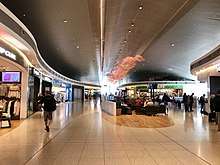
On 22 November 2015 the domestic pier of Terminal 1 was opened; the pier became the exclusive home to Virgin Australia.[28] Virgin Australia's partner, Etihad Airways began daily direct services from its hub in Abu Dhabi on 16 July 2014;[29] the pier ensures quick and seamless transfers between the two airlines. The pier will also be connected to Terminal 2 via an elevated walkway allowing seamless transfer to Virgin's regional services without having to be re-screened.
On 15 May 2016, the world's largest commercial jet airliner, the Antonov An-225 Mriya landed at Perth Airport, making its first visit to Perth and Australia.
On 11 December 2016, Qantas announced that it would commence non-stop flights from Perth to London Heathrow in March 2018 with one of their newly acquired Boeing 787 Dreamliners. To achieve this the Qantas domestic terminal at T3/T4 was upgraded during 2017 to cater for international flights. Once completed the existing Qantas flights to Singapore and Auckland also migrated to the same terminal. Services started in March 2018.[30]
On 22 February 2018, Singapore Airlines announced Perth would be the second destination, after Osaka, to receive services operated by the Boeing 787-10 Dreamliner, with flights starting from May 2018[31] Once launched, Perth will be one of the first airports in the world to operate all three variants of the Boeing Dreamliner.
On 10 April 2018, Etihad Airways announced that they would be ceasing Perth services from 1 October 2018. From 14 April 2018 Etihad Airways would downgrade the service from a Boeing 787-9 Dreamliner to an Airbus A330-200.
Qantas CEO Alan Joyce also stated that more direct flights to Europe will follow after its Perth to London flights begin which include Paris, Frankfurt, Berlin and Rome. The airline might also include Perth in their new ultra long-haul flight plan dubbed "Project Sunrise", where flights between Perth and North American cities such as Los Angeles and Vancouver are possible.[32]
Facilities and services
Perth Airport has four main terminals and one minor terminal:[33]

- On the eastern side of the airport (location of the future consolidated terminal precinct) is,
- Terminal 1 (T1), the international terminal, caters for flights originating or departing outside Australia, with five jetways and a total of eight gates including a Multi Access Ramp System which allows dual boarding of aircraft including the Boeing 777 and Airbus A380. There are four airline lounges: the Emirates lounge; Singapore Airlines Silver Kris lounge; the Air New Zealand Lounge and Qantas Captains Club. The Emirates lounge has a second level and offer direct boarding on their flagship Airbus A380 aircraft. In November 2015, a new domestic pier opened at the west end of T1 to service Virgin Australia domestic flights.
- Terminal 2 (T2), is located to the immediate south west of T1. Virgin Australia Regional and Alliance commenced operations from T2 in 2013, and Tiger moved its operations there in 2013. Regional Express Airlines uses T2 for its services to Esperance and Albany.
- On the western side of the airport is the domestic terminal building, which is divided into two terminals,
- Terminal 3 (T3) has five jetways and a total of nine gates. Since 23 November 2015, it is currently used by Jetstar, although some Qantas services also operate from the terminal. It was the previous location for Virgin Australia and had a recently expanded member lounge, which utilised the space from the former Ansett Golden Wing Club / Alliance Airlines Lounge. The Qantas Group has exclusive use of both T3 and T4 since the movement of Virgin Australia to T1. From 24 March 2018 Qantas international departures will move from the International terminal to terminal 3[34]
- Terminal 4 (T4), the Qantas terminal, is operated by Qantas Group and is dedicated to the domestic operations of Qantas, QantasLink & their budget subsidiary Jetstar. The terminal has four jetways and a total of nine gates. It has two member lounge: The Qantas Club, which was expanded in March 2013 to cater for an additional 140 passengers;[35] and the Qantas Domestic Business Lounge, which opened in 2014. In 2018 Qantas opened a new international area in T4 as it had started flights from Perth to London. The Perth Airport Master Plan outlines these terminals will ultimately be demolished and replaced by new domestic facilities east of T1.
- A northern general aviation terminal, used primarily by charter aircraft, mainly for mining companies as fly-in fly-out services to remote operations.
Runways
Flights are serviced by two runways – the main 03/21 runway, 3,444 m × 45 m (11,299 ft × 148 ft) and 06/24, 2,163 m × 45 m (7,096 ft × 148 ft).
After a 10-month project, a reconstructed cross runway was opened on 21 October 2005.[36] The upgrades involved significant strengthening works and enlargement of turning nodes to accommodate regular operations by wide bodied aircraft, including the Airbus A380.[36]
Meteorological services
Meteorological services for Perth Airport commenced in May 1944, provided by the Guildford Meteorological Office situated at Ivy Street, Redcliffe.[37]
In March 1988, surface observations were moved to the recently vacated old airport tower on the northern side of the airfield (near what is now Terminal 3).[37] The Ivy Street location was retained for a time for radar services and the launching and tracking of weather balloons.[37] In October 1997, all operations from the Ivy Street Office and Old Control Tower were transferred to a newly constructed office on the Northern Perimeter Road in Belmont, in the north-eastern corner of the airfield.[37]
Landing patterns and approach
Perth Airport resides within the Melbourne FIR, which is managed by Melbourne Centre and operated by Airservices Australia.[38]
Perth Approach Control then guides the aircraft to their final approach. Once an aircraft is established on its final approach, control is handed over to Perth Tower.
Transport
Road access to Terminals 3 and 4 from the city centre is via Tonkin Highway and Dunreath Drive. Terminals 1 and 2 are accessed via Tonkin Highway and Airport Drive. All terminals are serviced by a number of private charter bus operators that can normally be accessed through most major hotels in the city centre.
Transperth operates route 935 to Kings Park via Belmont Forum and Perth City,[39] and route 40 to the Elizabeth Quay Bus Station via the Great Eastern Highway and Victoria Park bus station,[40] both from Terminal 4. Terminal 1 is serviced by route 380 to Perth City via Belmont Forum.[41] A large number of taxi companies have set up operations in the past, and provide transport facilities from the airport to other parts of the city.
The airport is not currently serviced by rail, however the construction of the Forrestfield-Airport Link will connect the airport to the Midland Line[42][43] in 2021.[44]
Observation areas
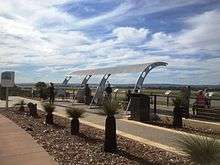
There are two dedicated spotting areas at Perth Airport. The T1 International Terminal houses an Observation Deck on Level 3 to view departing and arriving aircraft. It has vending machines, toilets and FIDSs.
The second spotting area is to the west side opposing the threshold of Runway 03 located along Dunreath Drive. The public viewing area has a shelter in the shape of the body section of a Boeing 747, and displays of information about the history of aviation.[45]
Other services
The Australian Transport Safety Bureau has its Perth regional office on Level 2 of the Hkew Alpha Building on the property of Perth Domestic Airport.[46]
Since May 2014, terminals T1 International, T2 Regional and T3 Domestic have a free Wi-Fi connection currently powered by iiNet. It is accessible throughout the entirety of the departure and arrival areas. Currently, T4 Qantas Domestic also has a free Wi-Fi service provided by Qantas.
The Royal Automobile Club of Western Australia (RAC) had a purpose-built driver training facility at Perth Airport, the only one of its kind in the state.[47] It was located towards the east of the current T1 International Terminal on Grogan Road.
Airlines and destinations
Perth Airport is served by 34 scheduled airlines flying to over 50 destinations in Australia, Oceania, Asia, Africa and Europe. A total of 1258 scheduled domestic and regional flights arrive and depart from Perth Airport each week. On the international front, a total of 213 scheduled[48] international flights arrive and depart from Perth Airport each week.
The following carriers operate to the following destinations:[49][50]
Passenger
| Airlines | Destinations |
|---|---|
| Air Mauritius | Mauritius |
| Air New Zealand | Auckland Seasonal: Christchurch |
| AirAsia X | Kuala Lumpur–International |
| Airnorth | Seasonal: Darwin, Kununurra |
| Alliance Airlines | Charter: Barimunya, Cape Preston, Christmas Creek, Christmas Island, Coondewanna, Kalgoorlie, Karratha, Leinster, Leonora, Mount Keith, Newman, Paraburdoo, Port Hedland, Telfer, The Granites[51] |
| All Nippon Airways | Tokyo–Narita[52] |
| Batik Air | Denpasar[53] |
| Cathay Pacific | Hong Kong |
| China Southern Airlines | Guangzhou |
| Citilink | Denpasar[54] |
| Cobham | Charter: Barrow Island, Kambalda, Granny Smith, Murrin Murrin |
| Emirates | Dubai–International |
| Garuda Indonesia | Denpasar, Jakarta–Soekarno-Hatta |
| Indonesia AirAsia | Denpasar, Mataram–Lombok,[55] Surabaya |
| Jetstar Airways | Adelaide,[56] Cairns, Denpasar, Gold Coast,[57] Melbourne, Sydney |
| Malaysia Airlines | Kota Kinabalu, Kuala Lumpur–International |
| Malindo Air | Kuala Lumpur–International |
| Maroomba Airlines | Mount Magnet |
| Philippine Airlines | Manila[58] |
| Qantas | Adelaide, Brisbane, Canberra, Darwin, London–Heathrow,[59] Melbourne, Singapore,[60] Sydney |
| QantasLink | Adelaide, Alice Springs, Broome, Darwin, Exmouth, Geraldton, Kalgoorlie, Karratha, Newman, Paraburdoo, Port Hedland Charter: Christmas Creek, Cloudbreak, Coyote, Ginbata, Leinster, Morawa, Solomon |
| Qatar Airways | Doha |
| Regional Express Airlines | Albany, Carnarvon, Esperance,[61][62] Monkey Mia |
| Scoot | Singapore |
| Singapore Airlines | Singapore |
| Skippers Aviation | Burnakura, Darlot-Centenary, Jundee, Kalbarri, Laverton, Lawlers, Leinster, Leonora, Meekatharra, Mount Magnet, Plutonic, Sunrise Dam, Wiluna |
| South African Airways | Johannesburg–O.R. Tambo |
| Thai Airways | Bangkok–Suvarnabhumi |
| Tigerair Australia | Melbourne, Sydney[63] |
| Virgin Australia | Adelaide, Brisbane, Darwin, Hobart,[64] Kalgoorlie, Karratha, Melbourne, Newman, Port Hedland, Sydney |
| Virgin Australia Regional Airlines | Adelaide, Alice Springs, Broome, Christmas Island, Cocos (Keeling) Islands, Darwin, Kalgoorlie, Karratha, Kununurra, Newman, Onslow, Port Hedland Charter: Argyle, Albany, Barimunya, Barrow Island, Boolgeeda, Nifty, West Angelas, Woodie Woodie, Onslow, Busselton |
Notes
Cargo
Many major cargo airlines operate regular visits to Perth Airport as Charter Flights. These include: Singapore Airlines Cargo, Emirates SkyCargo, Korean Air Cargo and Atlas Air.
| Airlines | Destinations |
|---|---|
| Toll Priority | Brisbane, Melbourne |
| Qantas Freight | Melbourne |
Charter and mining airlines
These airlines provide regular charters for mining companies in Western Australia:
- Ad Astral Aviation
- Alliance Airlines
- AvWest
- Cobham
- Formula Aviation
- Maroomba Airlines
- Network Aviation
- Skippers Aviation
- Virgin Australia Regional Airlines
- Star Aviation
- Casair
- Penjet
- Aerohire
Operations and statistics
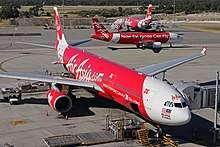
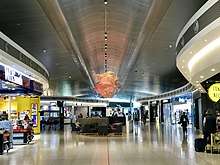
Total
Total passengers using the airport has increased on average by 5.8% annually since 1998–99, with 70% of passenger traffic at the airport attributed to domestic travel.[2]
| Year | Domestic | International | Total | Change |
|---|---|---|---|---|
| 1998–99 | 3,222,957 | 1,453,914 | 4,676,871 | |
| 1999–00 | 3,374,136 | 1,516,842 | 4,890,978 | |
| 2000–01 | 3,554,930 | 1,607,385 | 5,162,315 | |
| 2001–02 | 3,168,747 | 1,597,721 | 4,766,468 | |
| 2002–03 | 3,615,822 | 1,573,543 | 5,189,365 | |
| 2003–04 | 4,154,561 | 1,734,238 | 5,888,799 | |
| 2004–05 | 4,579,101 | 1,945,686 | 6,524,787 | |
| 2005–06 | 5,025,504 | 1,979,750 | 7,005,254 | |
| 2006–07 | 5,785,370 | 2,191,721 | 7,977,091 | |
| 2007–08 | 6,474,249 | 2,477,820 | 8,952,069 | |
| 2008–09 | 6,759,279 | 2,599,969 | 9,359,248 | |
| 2009–10 | 7,010,711 | 2,981,877 | 9,992,588 | |
| 2010–11 | 7,644,447 | 3,245,081 | 10,889,528 | |
| 2011–12 | 9,140,418 | 3,492,160 | 12,632,578 | |
| 2012–13 | 9,990,727 | 3,763,677 | 13,664,394 | |
| 2013–14 | 9,843,341 | 4,118,239 | 13,961,580 | |
| 2014–15 | 9,790,464 | 4,193,740 | 13,984,204 | |
| 2015–16 | 9,506,043 | 4,253,127 | 13,759,170 | |
| 2016–17 | 9,216,600 | 4,405,171 | 13,621,771 | |
| 2017–18 | 9,327,038 | 4,364,573 | 13,691,611 | |
| 2018–19 | 9,531,355 | 4,371,351 | 13,902,706 |
Domestic
| Rank | Airport | Passengers | % change |
|---|---|---|---|
| 1 | Melbourne | 2,033,242 | |
| 2 | Sydney | 1,716,477 | |
| 3 | Brisbane | 969,064 | |
| 4 | Adelaide | 614,141 | |
| 5 | Karratha | 436,887 | |
| 6 | Port Hedland | 337,347 | |
| 7 | Broome | 313,383 | |
| 8 | Newman | 284,874 | |
| 9 | Kalgoorlie | 241,869 | |
| 10 | Darwin | 198,365 |
International
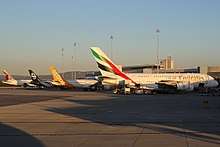
| Rank | Airport | Passengers handled | % Change |
|---|---|---|---|
| 1 | Singapore–Changi | 1,120,855 | |
| 2 | Denpasar | 889,007 | |
| 3 | Kuala Lumpur–International | 536,519 | |
| 4 | Dubai | 424,464 | |
| 5 | Doha | 244,716 | |
| 6 | Hong Kong | 226,553 | |
| 7 | Auckland | 182,929 | |
| 8 | Bangkok–Suvarnabhumi | 155,218 | |
| 9 | Johannesburg–O.R. Tambo | 136,090 | |
| 10 | Abu Dhabi | 115,780 |
Accidents and incidents
During construction
On 13 April 1987, a Hiller 12E helicopter was being used for the installation of a rotating beacon atop the control tower, then under construction. The beacon was attached to the helicopter for lifting by a chain sling. After the beacon had been lifted into place, workers disconnected the chain sling from it. As the helicopter was departing,
The hook on the sling became snagged on the tower guard rail ... causing it to pitch nose down and roll to the right. With the cable being tensioned by the pull of the helicopter the hook freed itself [and sprang] while crashing the strike side of the tower towards the helicopter. The cable flew up around the tail boom and became entangled in one of the main rotor blades. The other main rotor blade severed the tail boom which fell free of the helicopter striking the side of the tower on its way to the ground. The major section of the helicopter then fell to the ground at the base of the tower, caught fire and was burnt out.[67]
The accident resulted in the death of the helicopter pilot. The subsequent investigation conducted by the Australian Transport Safety Board, found that the pilot's licence was not endorsed for sling loading operations and he was not sufficiently current on the aircraft type to undertake such a job.[67]
Accidents en route
On 2 July 1949 a Douglas DC-3, named Fitzroy, departed from Perth Airport for Carnarvon. Moments after takeoff it crashed about a mile north of the airport, killing all 18 people on board.
On 26 June 1950 a Douglas DC-4 Skymaster, named Amana, departed from Perth Airport for Adelaide, South Australia. It crashed 22 minutes later, near York, Western Australia, killing 28 of the 29 occupants. The sole survivor died in a Perth hospital six days later. This accident and the TAA Fokker Friendship disaster remain Australia's worst civil aviation accidents.
Emergency alternative airports
There are three emergency alternative airports for Perth, used usually in the case of fog or bad weather affecting Perth. In 2013, the state government flagged the need for a new emergency alternative airport, with Exmouth's Learmonth Airport and Adelaide Airport being inconvenient due to their significant distance from Perth.[68] In 2017, plans for Cunderdin Airport to become a diversion airport for Perth were put in place.[69] In 2018, it was proposed that Kalgoorlie-Boulder Airport would be a better alternative than Cunderdin.[70] In 2019, Busselton Margaret River Airport had its bid to become a designated alternate international airport approved.[71]
Redevelopment plans
Consolidation of terminals
The Perth Airport Master Plan 2014[72] aims for the domestic and international terminals to be consolidated into a single terminal on the south-eastern side of the airfield by 2024.[73] In 2008, Westralia Airports announced their intention to complete a A$1 billion upgrade project which addresses key elements of the Master Plan while complete the upgrade project key elements of the 2014 Master Plan.[74]
Third runway
The construction of a new runway (03R/21L) is planned. The new runway will be 3,000 metres (9,800 ft) long and 45 metres (148 ft) wide, while it was the running parallel to the existing main runway and located between Terminal 1 and Abernethy Road.[75] Although Perth Airport plans for the runway to open by 2027, if demand is high enough in the coming years, the airport will set a 2024 opening instead, the same year the terminals are expected to be consolidated.[76]
Forrestfield-Airport Rail Link
On 3 November 2016, a commuter rail link started construction, with the Airport Central station linking the consolidated terminal with the Transperth railway network,[77] while it was connecting with the Midland Line between Bayswater station and Ashfield station. The rail link is expected to be completed by 2021, and will be underground for much of its length.[78]
See also
- List of airports in Western Australia
- Transport in Australia
References
- "Airport Statistics". Perth Airport. 2018. Retrieved 29 December 2018.
- "Airport Traffic Data 1985–86 to 2010–11". Archived from the original on 24 March 2012. Retrieved 13 June 2017.
- "Guide to Statutory Outgoings 2017–18" (PDF). Perth Airport. Retrieved 3 March 2018.
There are three local authorities in which Perth Airport resides; City of Belmont, City of Swan and City of Kalamunda.
- "Movements at Australian Airports, 2017 Calendar Year Totals" (PDF). Airservices Australia. 29 January 2018. Retrieved 8 July 2018.
- Air passenger movements through capital city airports to 2025–26 (PDF) (Working Paper 72). Canberra, Australia: Bureau of Infrastructure, Transport and Regional Economics (BITRE). May 2008. ISBN 978-1-921260-23-0. Retrieved 29 December 2018.
- "Perth Airport worst in Australia, again". PerthNow. 17 May 2012.
- "Perth Airport awarded capital city airport of the year". Australian Aviation. Retrieved 26 March 2017.
- Airport, Perth (26 April 2018). "ACCC rates Perth Airport Australia's best". www.perthairport.com.au. Retrieved 5 May 2018.
- Tillett, Andrew; Thomas, Geoffrey (17 October 2012). "Man racks up 21,000 complaints in crusade against aircraft noise". The West Australian. Retrieved 8 July 2018.
- Law, Peter (18 January 2015). "Aircraft noise complaints double across Perth". PerthNow. Retrieved 8 July 2018.
- "Aircraft Noise Impacts". City of Canning, Government of Western Australia. Retrieved 8 July 2018.
- "Guildford Hazelmere Local Area Plan" (PDF). City of Swan. 11 May 2015. p. 36. Retrieved 8 July 2018.
- "State Planning Policy 5.1 Land use planning in the vicinity of Perth Airport" (PDF). Department of Planning, Government of Western Australia. July 2015. p. 8. Retrieved 8 July 2018.
- Perth Airport 1944–1994, 50 Years of civil aviation. Mascot, New South Wales: Federal Airports Corporation. 1994.
- Flamer, Gabriel (November 1962). My big brother – A First History of Perth Airport. Graylands, Western Australia: Graylands Teachers College.
- "20 Year Anniversary of Terminal 1 (International) – 1986 to 2006". Westralian Airports Corporation. 2006. p. 2. Retrieved 12 May 2007.
- "Access road to new International Airport to be named Horrie Miller Drive in honour of WA pioneer aviator". The West Australian. 1 December 1984. p. 40.
- "Perth Tower". Airservices Australia, Commonwealth of Australia. Archived from the original on 13 June 2007. Retrieved 3 July 2007.
- "History". Perth Airport. Retrieved 2 December 2017.
- "Perth Airport celebrates 60th anniversary of first international service". Westralian Airports Corporation. 16 June 2006. p. 1. Archived from the original (PDF) on 29 August 2007. Retrieved 12 May 2007.
- "A380 in emergency Perth landing". WAtoday. 15 August 2009. Retrieved 8 October 2010.
- "Qatar Airways' Dreamliner flight to Perth in doubt, as 787s are grounded". The Australian. 18 January 2013. Retrieved 10 April 2013.
- "Qatar Airways plans A350 flights for Perth, delays Auckland launch". Australian Business Traveller. 4 May 2016. Retrieved 6 May 2016.
- "Airport redevelopment". Westralian Airports Corporation. Archived from the original on 4 April 2011. Retrieved 7 April 2011.
- Transforming The International Experience at official website. Accessed 16 May 2012.
- "Emirates brings A380 to WA". Retrieved 31 December 2014.
- "Emirates goes double-daily A380 with second superjumbo for Perth". Retrieved 13 June 2017.
- "New airport terminal 'world class'". Archived from the original on 8 December 2015. Retrieved 27 October 2015.
- Beattie, Fraser. "Etihad opens flights from Perth to Abu Dhabir". Online. Business News. Retrieved 29 July 2015.
- "QANTAS TO FLY NON-STOP PERTH TO LONDON". Qantas Newsroom. Qantas. Retrieved 11 December 2016.
- "Perth to be Australia's first Boeing 787-10 destination". Australian Aviation. Retrieved 23 February 2018.
- "Qantas closes in on decision about plane that could fly Perth to Los Angeles nonstop". The West Australian. 12 March 2018. Retrieved 17 March 2018.
- "About Perth Airport". Westralian Airports Corporation. Archived from the original on 17 June 2006. Retrieved 3 July 2007.
- "Qantas details new Perth Airport T3 'international terminal wing'". Australian Business Traveller. Retrieved 13 March 2018.
- "Qantas Expands Lounge at Perth Airport". DomesticFlightAustralia.com.
- "Cross-runway at Perth Airport re-opens, A380 ready!" (PDF) (Press release). Westralian Airports Corporation. 21 October 2005. Retrieved 7 September 2007.
- "About Perth Airport Meteorological Office". Bureau of Meteorology, Commonwealth of Australia. Archived from the original on 9 July 2003. Retrieved 12 May 2007.
- "Melbourne Centre". Airservices Australia, Commonwealth of Australia. Archived from the original on 11 April 2005. Retrieved 3 July 2007.
- Route 935 timetable Transperth
- Route 40 timetable Transperth
- Route 380 timetable Transperth
- 8 km Forrestfield-Airport Link tunnel revealed Archived 15 April 2015 at the Wayback Machine Government of Western Australia 9 August 2014
- Perth rail link approved Railway Gazette International 13 August 2014
- Forrestfield-Airport Link Public Transport Authority August 2014
- Public viewing area at official website. Accessed 16 May 2012.
- "Contact Us." Australian Transport Safety Bureau. Retrieved 20 May 2011. "Perth Regional Office Level 2, Hkew Alpha Building, 2 George Wiencke Drive, Perth Domestic Airport, WA 6105"
- "Driving Training and Education Centre". The Royal Automobile Club of Western Australia. Retrieved 8 July 2018.
- "2015 – August". Retrieved 9 August 2015.
- "Route maps". Perth Airport. Retrieved 6 March 2018.
- Paige Taylor (9 November 2011). "Flight marks first direct link between Perth and China". The Australian.
- "Where We Fly". www.allianceairlines.com.au. Retrieved 13 June 2017.
- "All Nippon Airways confirms Tokyo-Perth service". www.airlineratings.com. 26 December 2018. Retrieved 26 December 2018.
- Thomas, Geoffrey (27 December 2018). "Lion Air Group's Batik Air reinstates Perth to Bali flights". The West Australian. Retrieved 29 December 2018.
- https://www.routesonline.com/news/38/airlineroute/285902/citilink-adds-perth-service-from-late-oct-2019/
- "Perth and Lombok skies officially open". AirAsia. Retrieved 9 June 2019.
- Jetstar quits Lombok Perth Brisbane Flights. blogs.crikey.com.au (10 June 2014). Retrieved on 15 July 2014.
- "Sales and special deals – Jetstar". www.jetstar.com. Retrieved 13 June 2017.
- "Philippine Airlines resumes Perth service in late-March 2020". Retrieved 6 December 2019.
- Flynn, David (27 April 2017). "Qantas' non-stop Perth-London Boeing 787 flights start March 24". ausbt.com.au. Australian Business Traveller. Retrieved 27 April 2017.
- "Perth-Singapore Qantas route returns". PerthNow. Archived from the original on 20 May 2015. Retrieved 13 June 2017.
- "Rex named as preferred tenderer for two WA govt contracts – Australian Aviation". australianaviation.com.au. Retrieved 13 June 2017.
- 2017, UBM (UK) Ltd. "Rex Adds New Western Australia Routes from late-Feb 2016". Routesonline. Retrieved 13 June 2017.CS1 maint: numeric names: authors list (link)
- Australian Aviation – Tigerair to start Sydney-Perth. Australianaviation.com.au. Retrieved on 27 September 2013.
- 2017. "Hobart-Perth direct flights to begin in September as Virgin readies to head west". ABC News. Retrieved 4 July 2018.CS1 maint: numeric names: authors list (link)
- "Australian Domestic Aviation Activity Annual Publications". Bureau of Infrastructure, Transport and Regional Economics (BITRE). March 2018. Retrieved 11 April 2018. Refers to "Regular Public Transport (RPT) operations only"
- "International Airline Activity 2018". bitre.gov.au. June 2019. Retrieved 17 June 2019.
- Hiller UH12E, Perth WA, 13 April 1987: Investigation Number:198700097 at Aviation safety investigations & reports, Australian Transport Safety Bureau, 5 November 1987
- "First steps to second Perth airport". couriermail.com.au. 24 September 2013. Archived from the original on 29 September 2019.
- Thomas, Geoffrey (4 February 2017). "$200m plan for backup WA airport". The West Australian. Retrieved 18 February 2017.
- Watkinson, Neil (20 February 2018). "Kalgoorlie airport a better flight plan than Wheatbelt: MP". Kalgoorlie Miner. Retrieved 29 September 2019.
- "Busselton Margaret River Airport designated as an international alternate airport". busseltonmail.com.au. 1 April 2019. Archived from the original on 4 April 2019.
- "2024 Airport Master Plan, Perth Airport". Westrailia Airports Corporation. p. 1. Archived from the original on 17 June 2006. Retrieved 12 May 2007.
- "2024 Passenger Facilities Development Plan, 2014 Master Plan, Perth Airport". Westrailia Airports Corporation. p. 1. Archived from the original (PDF) on 7 March 2007. Retrieved 12 May 2007.
- Creedy, Steve (2 May 2008). "Westralia cash flow to fund terminals". The Australian. Archived from the original on 2 May 2008. Retrieved 3 May 2008.
- The third runway Archived 31 January 2015 at the Wayback Machine at official website. Accessed 03 Jan 2015.
- Geoffrey Thomas. "Perth Airport unveils $2.5b expansion plan". Perth Now. Retrieved 7 October 2017.
- "Public Transport Link Option, 2014 Master Plan, Perth Airport". Westrailia Airports Corporation. p. 1. Archived from the original (PDF) on 7 March 2007. Retrieved 12 May 2007.
- Joe Spagnolo (10 August 2014). "Perth Airport rail link to start in 2016 and be finished by 2020, says WA Premier Colin Barnett". Sunday Times. Archived from the original on 30 March 2015. Retrieved 1 March 2015.
